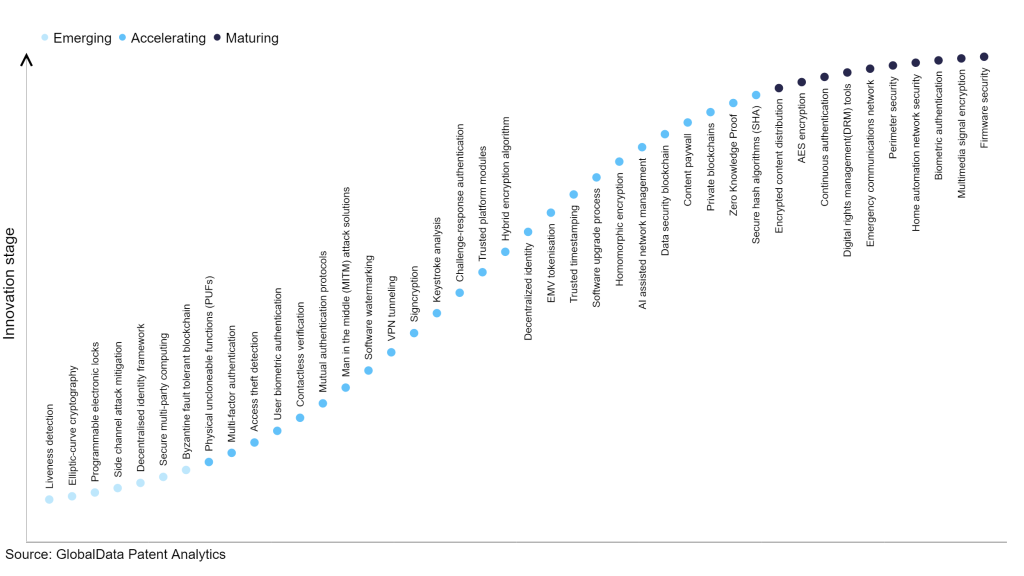The technology industry continues to be a hotbed of innovation, with activity driven by digital transformation and the increasing need to thwart the threats posed by piracy, unauthorised access, and data breaches, and growing importance of technologies such as digital rights language (DRL), trusted execution environments (TEE), digital watermarking, content protection systems, secure digital containers, and digital rights management (DRM) systems. In the last three years alone, there have been over 3.6 million patents filed and granted in the technology industry, according to GlobalData’s report on Innovation in Cybersecurity: Digital rights management (DRM) tools. Buy the report here.
However, not all innovations are equal and nor do they follow a constant upward trend. Instead, their evolution takes the form of an S-shaped curve that reflects their typical lifecycle from early emergence to accelerating adoption, before finally stabilising and reaching maturity.
Identifying where a particular innovation is on this journey, especially those that are in the emerging and accelerating stages, is essential for understanding their current level of adoption and the likely future trajectory and impact they will have.
300+ innovations will shape the technology industry
According to GlobalData’s Technology Foresights, which plots the S-curve for the technology industry using innovation intensity models built on over 2.5 million patents, there are 300+ innovation areas that will shape the future of the industry.
Within the emerging innovation stage, byzantine fault tolerant blockchain, secure multi-party computing, and decentralised identity framework are disruptive technologies that are in the early stages of application and should be tracked closely. Secure hash algorithms (SHA), Zero Knowledge Proof and Private blockchains are some of the accelerating innovation areas, where adoption has been steadily increasing. Among maturing innovation areas are multimedia signal encryption and firmware security, which are now well established in the industry.
Innovation S-curve for cybersecurity in the technology industry

Digital rights management (DRM) tools is a key innovation area in cybersecurity
DRM tools encompass a range of technologies employed by content providers to regulate the usage and dissemination of their copyrighted material. They serve as safeguards against unauthorised copying, distribution, or alteration of digital content. Encryption and watermarking techniques are examples of DRM tools that hinder users from copying, printing, or saving digital content without proper authorisation. Additionally, DRM tools enable tracking of content usage to ensure compliance with license agreements and prevent misuse.
GlobalData’s analysis also uncovers the companies at the forefront of each innovation area and assesses the potential reach and impact of their patenting activity across different applications and geographies. According to GlobalData, there are 100+ companies, spanning technology vendors, established technology companies, and up-and-coming start-ups engaged in the development and application of digital rights management (DRM) tools.
Key players in digital rights management (DRM) tools – a disruptive innovation in the technology industry
‘Application diversity’ measures the number of different applications identified for each relevant patent and broadly splits companies into either ‘niche’ or ‘diversified’ innovators.
‘Geographic reach’ refers to the number of different countries each relevant patent is registered in and reflects the breadth of geographic application intended, ranging from ‘global’ to ‘local’.
Patent volumes related to digital rights management
Source: GlobalData Patent Analytics
Microsoft is one of the leading filers in digital rights management. The company’s patents are aimed at systems and methods that leverage cybersecurity and digital rights management tools to design machines that can determine if the digital content item includes a reference indicator that indicates that the digital content item is copied original content. The machine determines that the digital content item is at least one of a near-duplicate or an exact duplicate of an original digital content item based on a comparison between data pertaining to the digital content item and the original digital content item. The machine enhances the server based on executing a treatment of the digital content item.
Other prominent patent filers in the space include Samsung and Sony.
By geographic reach, Tangentix leads the pack, followed by KDDI and EchoStar. In terms of application diversity, KDDI holds the top position, followed by NEC and Netflix.
Cybersecurity innovation is of paramount importance in the realm of digital rights management (DRM) tools. As technology evolves, so do the threats posed by piracy, unauthorised access, and data breaches. DRM providers must continually develop and implement robust security measures to safeguard digital content and protect the rights of content creators and copyright holders.
To further understand how cybersecurity is disrupting the technology industry, access GlobalData’s latest thematic research report on Cybersecurity – Thematic Research.
Data Insights
From

The gold standard of business intelligence.
Blending expert knowledge with cutting-edge technology, GlobalData’s unrivalled proprietary data will enable you to decode what’s happening in your market. You can make better informed decisions and gain a future-proof advantage over your competitors.







